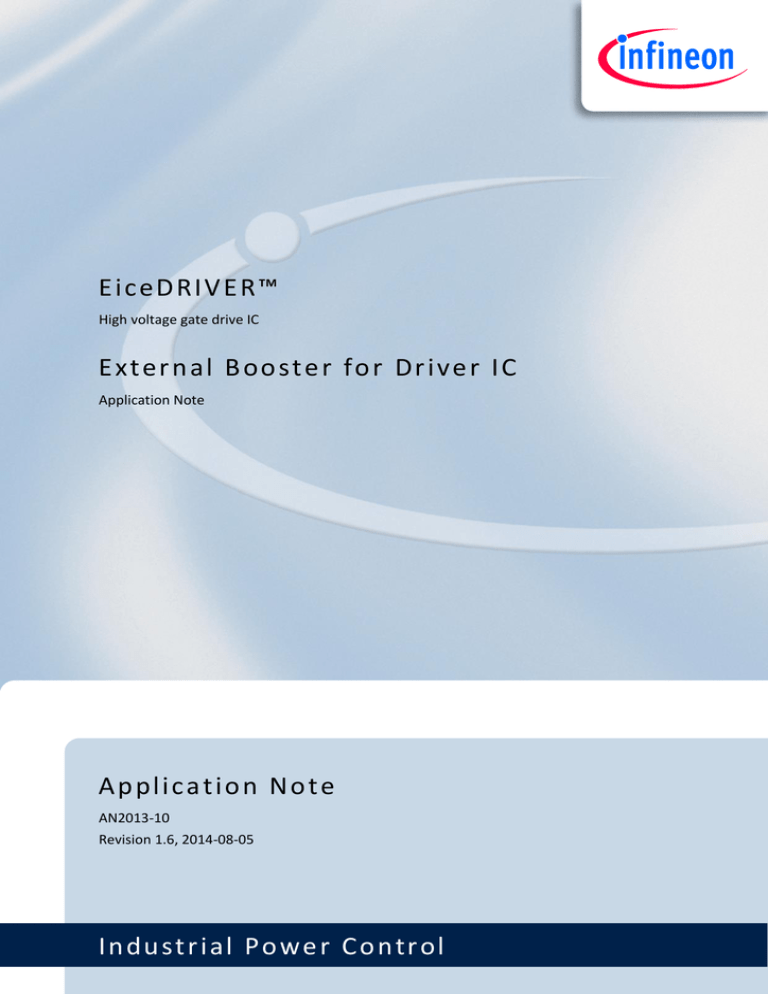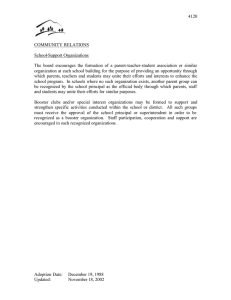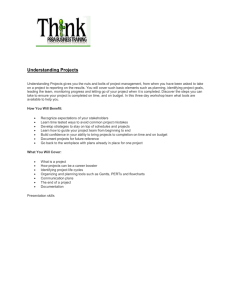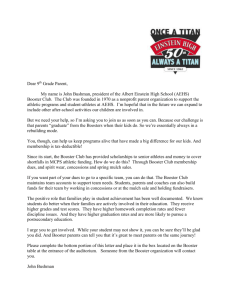
Ei c eD RI VE R™
High voltage gate drive IC
E xt er nal B ooste r fo r D riv er IC
Application Note
Ap pl ic at io n No te
AN2013-10
Revision 1.6, 2014-08-05
In d ust ria l Power C o n tro l
Edition 2014-08-05
Published by
Infineon Technologies AG
81726 Munich, Germany
© 2014 Infineon Technologies AG
All Rights Reserved.
LEGAL DISCLAIMER
THE INFORMATION GIVEN IN THIS APPLICATION NOTE IS GIVEN AS A HINT FOR THE IMPLEMENTATION OF THE
INFINEON TECHNOLOGIES COMPONENT ONLY AND SHALL NOT BE REGARDED AS ANY DESCRIPTION OR
WARRANTY OF A CERTAIN FUNCTIONALITY, CONDITION OR QUALITY OF THE INFINEON TECHNOLOGIES
COMPONENT. THE RECIPIENT OF THIS APPLICATION NOTE MUST VERIFY ANY FUNCTION DESCRIBED HEREIN IN
THE REAL APPLICATION. INFINEON TECHNOLOGIES HEREBY DISCLAIMS ANY AND ALL WARRANTIES AND
LIABILITIES OF ANY KIND (INCLUDING WITHOUT LIMITATION WARRANTIES OF NON-INFRINGEMENT OF
INTELLECTUAL PROPERTY RIGHTS OF ANY THIRD PARTY) WITH RESPECT TO ANY AND ALL INFORMATION GIVEN
IN THIS APPLICATION NOTE.
Information
For further information on technology, delivery terms and conditions and prices, please contact the nearest
Infineon Technologies Office (www.infineon.com).
Warnings
Due to technical requirements, components may contain dangerous substances. For information on the types
in question, please contact the nearest Infineon Technologies Office.
Infineon Technologies components may be used in life-support devices or systems only with the express
EiceDRIVER™
External Booster for Driver IC
Revision History: 2013-09 Rev.1.0
Page or Item
Subjects (major changes since last revision)
Previous Version: 1.0
Author: Jinsheng Song
Trademarks of Infineon Technologies AG
AURIX™, C166™, CanPAK™, CIPOS™, CIPURSE™, EconoPACK™, CoolMOS™, CoolSET™,
CORECONTROL™, CROSSAVE™, DAVE™, DI-POL™, EasyPIM™, EconoBRIDGE™, EconoDUAL™,
EconoPIM™, EconoPACK™, EiceDRIVER™, eupec™, FCOS™, HITFET™, HybridPACK™, I²RF™,
ISOFACE™, IsoPACK™, MIPAQ™, ModSTACK™, my-d™, NovalithIC™, OptiMOS™, ORIGA™,
POWERCODE™, PRIMARION™, PrimePACK™, PrimeSTACK™, PRO-SIL™, PROFET™, RASIC™,
ReverSave™, SatRIC™, SIEGET™, SINDRION™, SIPMOS™, SmartLEWIS™, SOLID FLASH™,
TEMPFET™, thinQ!™, TRENCHSTOP™, TriCore™.
Other Trademarks
Advance Design System™ (ADS) of Agilent Technologies, AMBA™, ARM™, MULTI-ICE™, KEIL™,
PRIMECELL™, REALVIEW™, THUMB™, µVision™ of ARM Limited, UK. AUTOSAR™ is licensed by
AUTOSAR development partnership. Bluetooth™ of Bluetooth SIG Inc. CAT-iq™ of DECT Forum.
COLOSSUS™, FirstGPS™ of Trimble Navigation Ltd. EMV™ of EMVCo, LLC (Visa Holdings Inc.). EPCOS™
of Epcos AG. FLEXGO™ of Microsoft Corporation. FlexRay™ is licensed by FlexRay Consortium.
HYPERTERMINAL™ of Hilgraeve Incorporated. IEC™ of Commission Electrotechnique Internationale. IrDA™
of Infrared Data Association Corporation. ISO™ of INTERNATIONAL ORGANIZATION FOR
STANDARDIZATION. MATLAB™ of MathWorks, Inc. MAXIM™ of Maxim Integrated Products, Inc.
MICROTEC™, NUCLEUS™ of Mentor Graphics Corporation. MIPI™ of MIPI Alliance, Inc. MIPS™ of MIPS
Technologies, Inc., USA. muRata™ of MURATA MANUFACTURING CO., MICROWAVE OFFICE™ (MWO) of
Applied Wave Research Inc., OmniVision™ of OmniVision Technologies, Inc. Openwave™ Openwave Systems
Inc. RED HAT™ Red Hat, Inc. RFMD™ RF Micro Devices, Inc. SIRIUS™ of Sirius Satellite Radio Inc.
SOLARIS™ of Sun Microsystems, Inc. SPANSION™ of Spansion LLC Ltd. Symbian™ of Symbian Software
Limited. TAIYO YUDEN™ of Taiyo Yuden Co. TEAKLITE™ of CEVA, Inc. TEKTRONIX™ of Tektronix Inc.
TOKO™ of TOKO KABUSHIKI KAISHA TA. UNIX™ of X/Open Company Limited. VERILOG™, PALLADIUM™
of Cadence Design Systems, Inc. VLYNQ™ of Texas Instruments Incorporated. VXWORKS™, WIND RIVER™
of WIND RIVER SYSTEMS, INC. ZETEX™ of Diodes Zetex Limited.
Last Trademarks Update 2011-11-11
Revision 1.6, 2014-08-05
EiceDRIVER™
External Booster for Driver IC
Table of Contents
Table of Contents
1
Introduction ............................................................................................................................. 5
2
External booster basics ............................................................................................................. 6
3
Device selection ........................................................................................................................ 8
4
Design considerations ............................................................................................................. 11
5
Design example....................................................................................................................... 13
6
References .............................................................................................................................. 16
Application Note
AN2013-10
4
Revision 1.6, 2014-08-05
EiceDRIVER™
External Booster for Driver IC
Introduction
1 Introduction
An external booster is used to extend the operating range of the driver IC to current levels beyond maximum
rating. To achieve this purpose, additional components will be necessary. For instance, the Infineon 1ED020I12F2 driver IC has a 2A driving capability, but to reach a higher than 2A driving capability used for driving larger
IGBTs or parallel driving, an external booster will be the most popular solution. In this configuration the driver
IC is used as a controller and an external booster transistor is employed to handle the higher current and heat
dissipation [1]. At the first glance, the external booster is not a complicated circuit. But often in real
applications questions rise up when considering the device selection (bipolar transistor or MOSFET) and also
the influence of the driver IC features (e.g. Clamping, DESAT, etc…). This application note will give the hints and
recommendations with focus on the above mentioned items.
Although 1ED020I12-F2 driver IC is mainly used in the examples, this application note can also be applied to
the most of the Infineon EiceDRIVER™ driver IC family (1ED, 2ED and 6ED) with exception of 1ED-SRC.
Application Note
AN2013-10
5
Revision 1.6, 2014-08-05
EiceDRIVER™
External Booster for Driver IC
External booster basics
2 External booster basics
A typical external booster circuit can normally be built with a discrete NPN/PNP complimentary output stage
which is added to the output of a driver IC. One possible implementation is shown in Figure 1. The NPN and
PNP booster transistors should be fast switching and have sufficient current gain to deliver the desired peak
output current. The circuit, seen in Figure 1, depicts the output external booster being used with an Infineon
1ED020I12-F2 driver IC.
+5V
+15V
VCC2
CVCC2
RDY
RDESAT
DESAT
IC DDESAT
/FLT
CDESAT
RST
+5V
To control
logic
NPN
RB
IB
T1
T2 IE
GATE
VCC
CVCC1
DProt
GND2
GND
ININ+
PNP
T3 RG
CVEE2
CLAMP
VEE2
RGint
-8V
1ED020I12-F2
Figure 1
Example circuit for driving large IGBT modules (bipolar supply for driver IC)
Here, the NPN transistor T2 is responsible for turning on the load T1 (IGBT or IGBT module) and PNP transistor
T3 is responsible for turning it off.
The basic concept is simple: the 1ED020I12-F2 driver IC feeds its output current into the base terminal of the
external NPN booster transistor during turning on. The booster transistor then multiplies this base current IB by
the DC current gain (hFE) of the boost transistor, with a much higher current IC at the collector. Equation (1) and
(2) provide a method to derive IC and IE from IB:
(1)
(2)
Finally, the emitter current IE will drive the load T1 (IGBT or IGBT module). Normally IC is far larger than IB
(IC>>IB) when driving the load, so IC will be used instead of IE in this application note. During turning off the PNP
transistor will work in the same way.
Application Note
AN2013-10
6
Revision 1.6, 2014-08-05
EiceDRIVER™
External Booster for Driver IC
External booster basics
With the external booster, the required output current from the driver IC is reduced by the factor of DC current
gain of the booster’s transistor. Most of the power dissipation burden is now placed upon the booster’s
transistor, instead of on the driver IC.
A proper gate resistor RG can be sized according to the power device and application requirement, and the base
resistor RB can be sized to provide the required base current according to the gain of the booster transistors.
These resistors need to have a suitable rating for repetitive pulse power to avoid degradation. In some
applications, it might be required to separate the turning on and turning off resistance for RG and RB. To focus
more on the selected topics, single RG and RB will be used in this application note.
Application Note
AN2013-10
7
Revision 1.6, 2014-08-05
EiceDRIVER™
External Booster for Driver IC
Device selection
3 Device selection
As a rule of thumb, the booster transistors T2 and T3 are dimensioned to provide enough peak collector
current ICpk to drive the load T1. This peak current can be calculated with the following simplified equation:
(3)
(4)
In this equation, ∆Vout is the voltage drop along the charging/discharging path. Normally with unipolar supply it
is VCC2 and with bipolar supply it is VCC2-VEE2. RGint is the internal gate resistance of the IGBT, RG is the gate
resistance between the external booster and the IGBT, and ICM is the maximum allowed peak pulse current.
In reality, the upper limit on output current for the external booster circuit is often limited by the maximum
power dissipation and junction temperature of the booster transistor (T2 or T3). So, the power dissipation and
maximum ratings of the booster transistors must be checked and verified for each individual circuit design. To
simplify the calculation for a transient behavior basing on non-constant gate current, the following equation (5)
can be used to do a quick power dissipation check with normalized application parameters:
(5)
Here PD is the power dissipation of the bipolar transistor, fS is the switching frequency, and QG is the gate
charge of the IGBT. The first portion of this equation is the whole power which is consumed along the path
from power supply to the gate of IGBT. The second portion is the power which is consumed by the gate
resistors, so that the difference is the power which is consumed by the booster’s transistor.
Now with the calculated PD, the junction temperature of the booster’s transistor can be derived as given in
equation (6) and (7):
(6)
(7)
TA is the ambient temperature, RTHJA is the thermal resistance between the junction and ambient, and TJmax is
the maximum allowed junction temperature for the selected bipolar transistor. The calculated junction
temperature TJ of the booster transistor must be lower than TJmax, otherwise the external booster will be
damaged.
This is just a simply approach to describe the thermal behavoir. More detail about the thermal modeling for
SMD components on PCB which dissipates significant power, please refer to the reference such as [2].
Application Note
AN2013-10
8
Revision 1.6, 2014-08-05
EiceDRIVER™
External Booster for Driver IC
Device selection
To allow the output of the external booster to track close to the driver IC output at low current (to preserve the
rail-to-rail capability), it may become necessary to add resistor (RE) from base to emitter on the booster
transistors as shown in Figure 2. The recommended value range is between 50Ω and 100Ω. Sometimes, when
very high gain transistors need to be used in the external booster, this RE could also be helpful to avoid
oscillations in the output stage with careful exercise.
NPN
Driver
IC
output
Figure 2
RB
RE
PNP
RG
To
IGBT
gate
Alternative booster stage configuration
Intrinsically, MOSFETs can also be used for an external booster, and the polarity issue can be solved by adding
an additional inverter (theoretically it can also be solved by using the inverting input pin from the driver IC side,
but then the DESAT and Active Miller Clamp feature can not be used when designing gate drives with
1ED020I12-F2) as shown in Figure 3. In this case several points may be considered when comparing the
difference between bipolar transistors and MOSFETs:
1) Voltage loss at output VCE(sat) for bipolar solution meanwhile MOSFET solution almost has a rail-to-rail
output.
2) Breakdown voltage limitation for MOSFET (~20V for VGS), which could be a problem when using a
bipolar power supply.
3) The booster with MOSFETs is prone to shoot through especially when supply voltage is beyond 15V.
Also, MOSFETs have negative temperature coefficient for threshold voltage Vth, this will make the
shoot through worse at higher temperature. This should be paid attention and carefully considered
when the MOSFETs are used for external booster.
4) Switching speed: bipolar transistors are normally switching slower than MOSFETs in an external
booster circuit.
5) Robustness of the booster’s input stage towards ESD and voltage surge: gate oxide vs PN junction.
6) Last but not least, the cost.
Application Note
AN2013-10
9
Revision 1.6, 2014-08-05
EiceDRIVER™
External Booster for Driver IC
Device selection
+5V
+15V
VCC2
CVCC2
RDY
RDESAT
DESAT
DDESAT
/FLT
PMOS
CDESAT
RST
+5V
To control
logic
RB
GATE
VCC
GND
ININ+
RG
DProt
CVCC1
GND2
NMOS
CLAMP
VEE2
1ED020I12-F2
Figure 3
Example circuit for external booster with MOSFET (unipolar supply for driver IC)
Application Note
AN2013-10
10
Revision 1.6, 2014-08-05
EiceDRIVER™
External Booster for Driver IC
Design considerations
4 Design considerations
When applying the external booster, there will be some influence to the application circuit and also to the
features of the driver IC, so some hints are noted here for design considerations:
1) The Active Miller Clamp feature of the 1ED020I12-F2 family can be used together with external booster
(mainly in the unipolar supply case). When the Miller current is larger than the maximum clamping
capability of driver IC (2A for 1ED020I12-F2), an additional sinking path will be needed along the
clamping path (between gate of IGBT and CLAMP pin). The booster transistor itself also has sinking
capability, but due to the exist of the gate resistor (RG), this sinking capability is probably not enough.
Figure 4 gives an example about how to implement this additional sinking path. Here the PNP_CLAMP
transistor should have the same current capability as the PNP transistor of the external booster.
RB_CLAMP is the base resistor for the PNP_CLAMP transistor, and the sizing is according to PNP_CLAMP
transistor. RP is used as a pull-up resistor for safety reasons, and the recommended value is in 10kΩ
range (to limit the current which runs through RP in mA range to save power).
+5V
+15V
VCC2
CVCC2
RDY
CBooster
RDESAT
DESAT
DDESAT
/FLT
CDESAT
RST
+5V
To control
logic
NPN
RB
GATE
VCC
CVCC1
DProt
GND2
GND
RB_CLAMP
ININ+
CLAMP
PNP
RG
RP
PNP_CLAMP
VEE2
1ED020I12-F2
Figure 4
Example circuit for Active Miller Clamp feature with external booster (unipolar supply for
driver IC)
2) It is possible when the bipolar supply is used that VEE2 is not at same potential as GND2 but has a
negative value. In this situation, the Active Miller Clamp feature is normally not necessary. The CLAMP
pin can simply be left open (as depicted in Figure 1). The resistance values of RG and RB need to be
adjusted accordingly since the voltage step (∆Vout = VCC2 –VEE2) is changed.
3) If the bipolar supply needs to be used together with the Active Miller Clamp feature, the additional
sinking path (PNP_CLAMP and RB_CLMAP as shown in Figure 4) needs to be adjusted accordingly with
different VEE2 value. Note that this configuration is possible since the CLAMP pin is internally reference
to VEE2 for Infineon 1ED driver IC family.
Application Note
AN2013-10
11
Revision 1.6, 2014-08-05
EiceDRIVER™
External Booster for Driver IC
Design considerations
4) The DESAT (desaturation detection) feature is functional and is not influenced by the external booster.
5) The TLTO (Two-Level Turn-Off) feature from the 1ED020I12-FT/BT driver IC is still functional with the
bipolar external booster, but can NOT be realized when using the MOSFETs external booster.
6) The power supply and the decoupling capacitor CVCC2 (as seen in Figure 1) need to be adjusted
according to the external booster to ensure the quality of supply voltage, which should be enough to
support the three main parts of the power consumption: the driver IC, the load (IGBT) and the external
booster. Alternatively a separate decoupling capacitor solution can be used to optimize the layout:
CVCC2 closes to the driver IC and CBOOSTER closes to external booster transistors (as shown in Figure 4).
7) When doing the layout, large parasitic inductance and especially capacitance should be avoided (e.g.
shorten the loop, avoid the overlap between the high dv/dt path and the ground path, etc…).
Application Note
AN2013-10
12
Revision 1.6, 2014-08-05
EiceDRIVER™
External Booster for Driver IC
Design example
5 Design example
To better understand it thoroughly, consider the calculations in the following example with real data. Using
Figure 1 as the reference design, the 1ED020I12-F2 is the driver IC. The Infineon 600A IGBT module
FZ600R12KP4 is used as the load, which can be driven properly by a 10A peak current. Now for the external
booster, the ZXTN2031F [3] is the NPN transistor and ZXTP2025F [4] is the PNP transistor, which are paired
transistors to each other and have similar parameters.
The operating conditions are:
Voltage step to drive the load with bipolar power supply: ∆Vout = 15.0V – (-8.0V) = 23.0V
Switching frequency: fs = 5kHz
Ambient temperature: TA = 80oC
According to the datasheet of the IGBT module FZ600R12KP4 [5]:
Gate charge: QG = 5.6µC (-15V…+15V value, for -8V…+15V range, it will be smaller)
RGint = 1.3Ω
RG = 1.2Ω
According to the datasheet of driver IC 1ED020I12-F2 [6]:
Output peak current: IOUTH = IOUTL = 2A (∆Vout = 23V)
According to the datasheet of bipolar transistors:
Collector-emitter breakdown voltage: V(BR)CEO = 50V > ∆Vout (23V)
Maximum allowed junction temperature: TJmax = 150 oC
Thermal resistance: RTHJA = 125 oC/W
For ZXTN2031F:
Pulse peak current: ICM = 12A
Static forward current transfer ratio: hFE = 80 (minimum value is use)
For ZXTP2025F:
Application Note
AN2013-10
13
Revision 1.6, 2014-08-05
EiceDRIVER™
External Booster for Driver IC
Design example
Pulse peak current: ICM = 10A
Static forward current transfer ratio: hFE = 70 (minimum value is taken)
First the calculation for the NPN transistor ZXTN2031F, which is responsible for turning on IGBT will be
explained:
According to equation (3) ICpk is calculated as:
ICpk = ∆Vout / (RGint + RG) = 23V / (1.3Ω + 1.2Ω) = 9.2A < ICM (12A)
According to equation (5), the power dissipation for the booster transistor is:
PD = ½ ∙ ∆Vout ∙ fS ∙ QG – (RGint + RG) ∙ (fS ∙ QG)2
= ½ ∙ 23V ∙ 5kHz ∙ 5.6µC – (1.3Ω + 1.2Ω) ∙ (5kHz ∙ 5.6µC)2
= 322mW – 70mW = 252mW
TJ = TA + RTHJA ∙ PD
= 80 oC + 125oC/W ∙ 252mW
= 80 oC + 31.5 oC
=105.7 oC < TJmax (150oC)
It is apparent with the above mentioned operating conditions, that the peak current and the junction
temperature are both under the maximum rating values, showing that this example application is running in
the safe range.
Now consider how to size the base resistor RB. This resistor is used to define the base current so as to control
the collector current according to the current gain hFE of the booster transistor. Since the most critical time
during switching is the peak current time, the ICpk value is used to derive the minimum base resistance
requirement, according to equation (1):
IB = IC / hFE
= 9.2A / 80
= 0.115A
From driver IC side, the driver IC output resistance RDS(on) can be calculated approximately by the voltage step
∆Vout divided by driver IC rated peak current:
Application Note
AN2013-10
14
Revision 1.6, 2014-08-05
EiceDRIVER™
External Booster for Driver IC
Design example
RDS(on) = ∆Vout / IOUTH
= 23V / 2A
= 11.5Ω
At the moment of turn on (peak current moment), the voltage step ∆Vout is applied across the driver IC output
resistance RDS(on) and the base resistance RB. Now the minimum base resistance RB can be calculated as:
RB_min = ∆Vout / IB – RDS(on)
= 23V / 0.115A – 11.5Ω
= 188.5Ω
The calculation for the PNP transistor ZXTN2025F follows the same procedure and the same criterion.
In case the unipolar supply and the Active Miller Clamp features are used as depicted in Figure 4, the
calculation needs to be adjusted by the new voltage step (∆V = VCC2). The sizing procedure and the calculation
of the clamping transistor PNP_CLAMP is similar to the PNP transistor of the external booster.
Concerning the power dissipation of the driver IC itself, please refer to the corresponding chapter in
Application Note 1ED family: Technical description [7].
Application Note
AN2013-10
15
Revision 1.6, 2014-08-05
EiceDRIVER™
External Booster for Driver IC
References
6 References
[1]
Application Note No. 159: Low-Cost, Linear Mode, 71 % Efficiency 380 mA LED Driver Demo using the
BCR401R, BCX68 & LUXEON® Rebel LEDs
http://www.infineon.com/dgdl/AN159.pdf?folderId=db3a304412b407950112b40d9afd0e79&fileId=db3a304
31ddc9372011dde4d59e6001a
[2]
Linear Superposition Speeds Thermal Modeling - Powerelectronics
http://powerelectronics.com/sitefiles/powerelectronics.com/files/archive/powerelectronics.com/thermal_management/thermal_management
_simulation/701PET21.pdf
[3]
ZXTN2031F Medium power transistor datasheet - Diodes, Inc.
http://www.diodes.com/datasheets/ZXTN2031F.pdf
[4]
ZXTN2025F Medium power transistor datasheet - Diodes, Inc.
http://www.diodes.com/datasheets/ZXTP2025F.pdf
[5]
Datasheet / Datenblatt IGBT-Module FZ600R12KP4 - Infineon
http://www.infineon.com/dgdl/ds_fz600r12kp4_2_2_deen.pdf?folderId=db3a304412b407950112b4095b0601e3&fileId=db3a304320896aa20120b345f54276c4
[6]
Datasheet / Datenblatt Driver IC 1ED020I12-F2 - Infineon
http://www.infineon.com/dgdl/Datasheet_1ED020I12F2_V2_final.pdf?folderId=db3a30432b16d655012b33fafdac11e2&fileId=db3a304330f68606013122ce5f36
49cb
[7]
Application Note 1ED family: Technical description
http://www.infineon.com/dgdl/Infineon+-+Application+Note+1ED+family+-+Technical+description+0912.pdf?folderId=db3a3043353fdc1601355231e5194784&fileId=db3a304336ca04c90136e958eed2361d
Application Note
AN2013-10
16
Revision 1.6, 2014-08-05
w w w . i n f i n e o n . c o m
Published by Infineon Technologies AG




